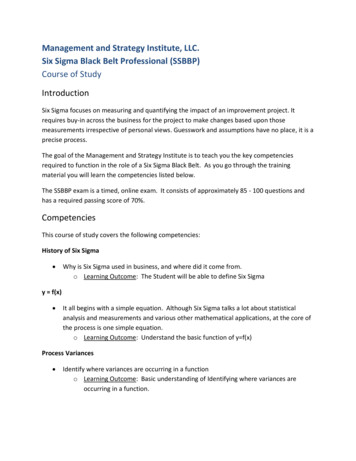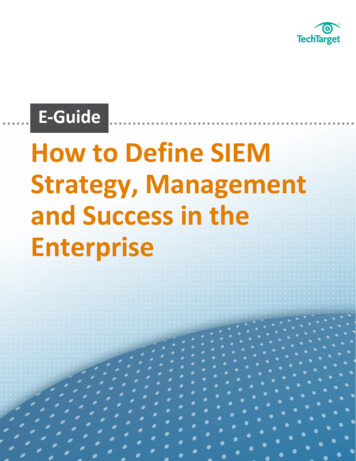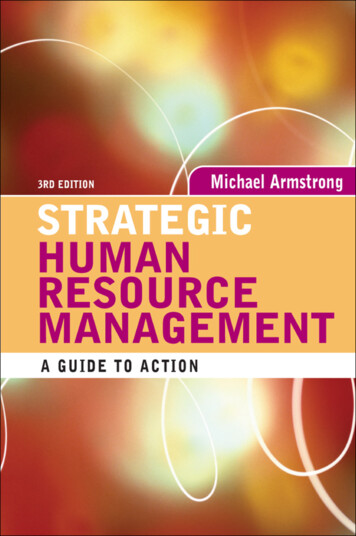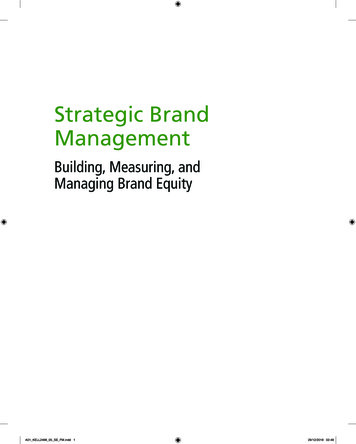
Transcription
STRATEGY, STRATEGICMANAGEMENT, STRATEGICPLANNING AND STRATEGICTHINKINGFred Nickols2016
STRATEGY, STRATEGIC PLANNING, STRATEGICTHINKING, STRATEGIC MANAGEMENTI NTRODUCTIONThis paper was first written when I was head of Strategic Planning & Management Services at Educational Testing Service (ETS). It examines the words andterms making up its title and presents them in a way intended to make themuseful tools for those charged with related duties.S TRATEGYStrategy is a word with many meanings and all of them are relevant and usefulto those who are charged with setting strategy for their corporations, businesses, or organizations. Some definitions of strategy as offered by various writersspanning the years 1962 to 1996 are briefly reviewed below.Alfred D. Chandler, Jr., author of Strategy and Structure (1962), the classic studyof the relationship between an organization’s structure and its strategy, definedstrategy as “the determination of the basic long-term goals and objectives of anenterprise, and the adoption of courses of action and the allocation of resourcesfor carrying out these goals.” (As we will see later, it is the allocation of resources that ties the civilian use of strategy to its military origins.)Robert N. Anthony, author of Planning and Control Systems (1965), one of thebooks that laid the foundation for strategic planning, didn’t give his own definition of strategy. Instead, he used one presented in an unpublished paper byHarvard colleague Kenneth R. Andrews: “the pattern of objectives, purposes orgoals and major policies and plans for achieving these goals stated in such a wayas to define what business the company is or is to be in and the kind of companyit is or is to be.” (Here we can see the emergence of some vision of the company in the future as an element in strategy.)Kenneth Andrews, long-time Harvard professor and editor of the Harvard Business Review, published the first edition of The Concept of Corporate Strategy in1971 and updated it in 1980. His published definition of strategy took this formin the 1980 edition: “the pattern of decisions in a company that determines andreveals its objectives, purposes or goals, produces the principal policies andplans for achieving those goals, and defines the range of businesses the company is to pursue, the kind of economic and human organization it is or intends tobe, and the nature of the economic and non-economic contribution it intends to Fred Nickols 2016Page 1
STRATEGY, STRATEGIC PLANNING, STRATEGICTHINKING, STRATEGIC MANAGEMENTmake to its shareholders, employees, customers, and communities.” (Andrews’definition of strategy is rather all-encompassing and is perhaps best viewed as avariation on the military notion of “grand strategy”.)George Steiner, a co-founder of the California Management Review, and authorof the 1979 “bible,” Strategic Planning: What Every Manager Must Know, observed that there was little agreement on terms or definitions and confined hisdiscussion of the definition of strategy to a lengthy footnote. But, nowheredoes he define strategy in straightforward terms.Michael Porter, another Harvard professor, became well known with the publication of his 1980 book, Competitive Strategy. Porter defined competitivestrategy as “a broad formula for how a business is going to compete, what itsgoals should be, and what policies will be needed to carry out those goals.” (Incontrast with Andrews’ definition, Porter’s is much narrower, focusing as it doeson the basis of competition.)Also published in 1980, was Top Management Strategy, by Benjamin B. Tregoe(of Kepner-Tregoe fame), and John W. Zimmerman, a long-time associate ofTregoe’s. They defined strategy as “the framework which guides those choicesthat determine the nature and direction of an organization.” (This definition isquite succinct but still includes “nature” and “direction.”)In 1994, Henry Mintzberg, an iconoclastic professor of management at McGillUniversity, took the entire strategic planning establishment to task in his book,The Rise and Fall of Strategic Planning. In effect, Mintzberg declared strategydid indeed have several meanings, all of which were useful. He indicated thatstrategy is a plan, a pattern, a position, a perspective and, in a footnote, he indicated that it can also be a ploy, a maneuver intended to outwit a competitor.A more recent entry appears in Strategic Planning for Public and Nonprofit Organizations, published in 1996 by John Bryson, professor of planning and publicpolicy at the University of Minnesota. Bryson defines strategy as “a pattern ofpurposes, policies, programs, actions, decisions, or resource allocations that define what an organization is, what it does, and why it does it.” Fred Nickols 2016Page 2
STRATEGY, STRATEGIC PLANNING, STRATEGICTHINKING, STRATEGIC MANAGEMENTIn the military, the strategy for a battle refers to a general plan of attack or defense. Typically, this involves arrangements made before actually engaging theenemy and intended to disadvantage that enemy. In this context, strategy isconcerned with the deployment of resources. In civilian terms, this amounts tothe “allocation” of resources. Tactics is the companion term and it refers to actions formulated and executed after the enemy has been engaged — “in theheat of battle,” as it were. Tactics, then, is concerned with the employment ofresources already deployed. In the civilian sector, this equates to operations inthe broad sense of that term. Generally speaking, tactical maneuvers are expected to occur in the context of strategy so as to ensure the attainment of strategic intent. However, strategy can fail and, when it does, tactics dominate theaction. Execution becomes strategy. Thus it is that, whether on the battlefieldor in business, the realized strategy is always one part intended (the plan asconceived beforehand) and one part emergent (an adaptation to the conditionsencountered). As a consequence, there are always two versions of a givenstrategy: (1) strategy as contemplated or intended and (2) strategy as realized.Although there are many similarities in the definitions above, there are alsosome important differences. We are left, then, with no clear-cut, widelyaccepted definition of strategy; only different views and opinions offered by different writers working different agendas.We come now to a definition of strategy that I proposed for use when I washead of Strategic Planning and Management Services at Educational TestingService:Strategy refers to a general plan of action for achieving one’s goals andobjectives.A strategy or general plan of action might be formulated for broad, long-term,corporate goals and objectives, for more specific business unit goals and objectives, or for a functional unit, even one as small as a cost center. Such goalsmight or might not address the nature of the organization, its culture, the kindof company its leadership wants it to be, the markets it will or won’t enter, thebasis on which it will compete, or any other attribute, quality or characteristic ofthe organization. As my definition implies, it is my view that strategy (and tactics) relate to how a given end is to be attained. Together, strategy and tactics Fred Nickols 2016Page 3
STRATEGY, STRATEGIC PLANNING, STRATEGICTHINKING, STRATEGIC MANAGEMENTbridge the gap between ends and means. Resources are allocated or deployedand then employed in the course of executing a given strategy so as to realizethe end in view. The establishment of the ends to be attained does indeed callfor strategic thinking, but it is separate from settling on the strategy that will realize them.Before coming to grips with the term “strategic planning,” it is best to examineeach of those terms separately. Let’s tackle “strategic” first.S TRATEGICSurprisingly, here there is ready agreement. But again there are different nuances. Clearly, strategic means “of or having to do with strategy.” Becausestrategies can and do exist at various levels of the organization, it is entirelyconceivable and appropriate for the corporation to have a strategic plan, for abusiness unit to have one too, and for a functional unit to have one. Strategicalso means “of great significance or import” and so strategic plans, at all levels,are intended to address matters of great importance. For those concerned withthe enterprise, strategic issues, initiatives, and plans are those that affect theentire enterprise in important ways. Chief among these are the direction anddestination of the firm. Where is it headed and what is it to become? Not allstrategic issues are long-term, although many are. A short-term crisis can be ofstrategic significance and should be dealt with accordingly. These considerations hold true at all levels of the organization. For our purposes, then, “strategic” means “of great importance.”Next in our series of terms to be examined are plans and planning.P LANSAND P LANNINGPlans of action, whether for business or the battlefield, always have two fundamental aspects: ends and means — what is to be achieved and how it is to beachieved. The ends sought might be broad, far-reaching, and off in the distantfuture. Or, they might be nearby, tightly focused, and well defined. And,whether we label these future results “goals,” “aims,” “targets,” or “objectives”is of little consequence. The same is true of the means chosen to attain one’sends. We might call these “programs,” “actions,” “steps,” “initiatives” or we Fred Nickols 2016Page 4
STRATEGY, STRATEGIC PLANNING, STRATEGICTHINKING, STRATEGIC MANAGEMENTmight even reuse the word “plans.” As is the case with ends, means, too, mightbe very broad or very narrow, and long-term or short-term.Needless to say, the scope and scale of our plans, thinking, and managerial activity varies. At least three levels of strategy and planning are widely accepted: enterprise level business unit level functional levelThose combinations of ends and means we call plans can be found at all threelevels of organization. Strategies, too, exist at all three levels. Consequently,one can and should find strategic thinking, planning, and management at allthree levels.Planning has been defined in various ways, ranging from thinking about the future to specifying in advance who is to do what when. For our purposes, we willdefine planning as “the activity of preparing a plan” and we will define a plan asa set of intended outcomes (ends) coupled with the actions by which those outcomes are to be achieved (means). To plan, then, is to specify the ends soughtand the means whereby they are to be attained.Planning can be formal or informal and involve lots of documentation or very little. The information base can be large and captured in a wide range of reports,studies, databases, and analyses, or it can rest entirely on the personalknowledge of a few people, or even just one. Plans, and thus the planning activities that produce them, frequently will address timeframes, either generally, orin the form of milestones and perhaps detailed schedules. Resources, too,might be addressed, whether in terms of money, space, equipment, or people.There are no predetermined, mandatory guidelines to follow; it is a matter ofdoing what is appropriate for the task at hand.Strategic planning is a different matter. Fred Nickols 2016Page 5
STRATEGY, STRATEGIC PLANNING, STRATEGICTHINKING, STRATEGIC MANAGEMENTS TRATEGIC P LANNINGStrategic planning is a defined, recognizable set of activities. Techniques varywith the particular author but the substantive issues are essentially the sameacross authors. These include: establishing and periodically confirming the organization’s mission andits corporate strategy (what has been termed “the context for managing”) setting strategic or enterprise-level financial and non-financial goals andobjectives developing broad plans of action necessary to attain these goals and objectives allocating resources on a basis consistent with strategic directions andgoals and objectives, and managing the various lines of business as aninvestment “portfolio” deploying the mission and strategy, that is, articulating and communicating it, as well as developing action plans at lower levels that are supportive of those at the enterprise level (one very specific method of policy or strategy deployment is known as Hoshin Kanri, a technique developed by the Japanese and subsequently used successfully by someAmerican businesses, most notably Hewlett Packard) monitoring results, measuring progress, and making such adjustmentsas are required to achieve the strategic intent specified in the strategicgoals and objectives reassessing mission, strategy, strategic goals and objectives, and plansat all levels and, if required, revising any or all of themThe techniques involved in strategic planning and management generally include some variation of the following: a strategic review or audit intended to clarify factors such as mission,strategy, driving forces, future vision of the enterprise, and the conceptof the business a stakeholders’ analysis to determine the interests and priorities of themajor stakeholders in the enterprise (e.g., board of trustees, employees,suppliers, creditors, clients, and customers) Fred Nickols 2016Page 6
STRATEGY, STRATEGIC PLANNING, STRATEGICTHINKING, STRATEGIC MANAGEMENT an assessment of external threats and opportunities as well as internalweaknesses and strengths (known variously as SWOT or TOWS), leadingto the identification and prioritization of strategic issues either as part of the assessment above, or as a separate exercise, theidentification of “core” or “distinctive competencies” also as part of the assessment above, or as separate exercises, the playing out of “scenarios” and even “war games” or simulations situational and ongoing “scans” and analyses of key sectors in the business environment, including industries, markets, customers, competitors, regulators, technology, demographics, and the economy, to namesome of the more prominent sectors of the environment various kinds of financial and operational performance audits intendedto flag areas where improvement might yield strategic advantageS TRATEGIC T HINKIN GANDM AN AGEMEN TObviously, a great deal of strategic thinking must go into developing a strategicplan and, once developed, a great deal of strategic management is required tobring its aims to fruition. But, as several authors have pointed out, the objectiveis indeed to think and manage strategically, not to blindly engage in strategicplanning for the sake of strategic planning. However, when it comes to specifying the substance of the distinctions among strategic thinking, strategic planningand strategic management, all authors are noticeably reticent. So, we will takethose distinctions as amounting to a well-meant caution against confusing theform of strategic planning with its substance.N ESTED C ONCEPTSOn my part, I have found it useful to view the concepts discussed in this paperas a set of “nested” concepts as depicted in Figure 1 below.As Figure 1 indicates, strategic thinking encompasses all the other concepts.Strategic management represents an effort to realize the fruits of strategicthinking. This occurs via strategy formulation, strategic planning, and strategydeployment (i.e., putting it all into action). Fred Nickols 2016Page 7
STRATEGY, STRATEGIC PLANNING, STRATEGICTHINKING, STRATEGIC MANAGEMENTFigure 1 – The “Nested” Concepts Related to StrategyC ONCLUSIONSStrategy is a useful concept, even in all its many variations. Strategic planning isa useful tool, of help in managing the enterprise, especially if the strategy andstrategic plans can be successfully deployed throughout the organization.Thinking and managing strategically are important aspects of senior managers’responsibilities, too. All these are part of what it takes to manage the enterprise. None of them is sufficient. Why? Because, if for no other reason, there isusually an existing book of business to manage. For most established firms, thiscan easily amount to 80 percent of the action. In other words, “strategic issues,” regardless of their importance, typically consume no more than 20 percent of the organization’s resources (although they frequently command 80percent of top management’s time and attention). To paraphrase an old saw,“The strategy wheel gets the executive grease.” This is as it should be. Seniormanagement should focus on the strategic issues, on the important issues facing the business as a whole, including where it is headed and what it will orshould become. Others can “mind the store.”R EFERENCES1. Andrews, Kenneth (1980). The Concept of Corporate Strategy, 2nd Edition. Dow-Jones Irwin.2. Bryson, John M. (1995). Strategic Planning for Public and Nonprofit Organizations. Jossey-Bass. Fred Nickols 2016Page 8
STRATEGY, STRATEGIC PLANNING, STRATEGICTHINKING, STRATEGIC MANAGEMENT3. Chandler, Alfred Jr. (1962). Strategy and Structure: Chapters in the History of the American Industrial Enterprise. MIT.4. Mintzberg, Henry (1994). The Rise and Fall of Strategic Planning. BasicBooks.5. Porter, Michael (1986). Competitive Strategy. Harvard Business SchoolPress.6. Steiner, George (1979). Strategic Planning. Free Press.7. Tregoe, Benjamin and John Zimmerman (1980). Top ManagementStrategy. Simon and Schuster.R ELATED A RTICLESIn addition to this paper, there are several other strategy-related articles on myweb site. A list of links follows. Sir Basil H. Liddell-Hart's Eight Maxims of StrategyCompetitive Strategy & Industry Analysis: The Basics A L A Michael PorterThe Goals Grid: A New Tool for Strategic PlanningA Strategic and Business Planning BibliographyStrategic Decision MakingStrategy: Definitions and MeaningStrategy Is ExecutionThree Forms of Strategy: General, Corporate & CompetitiveF OR M ORE I NFORMATIONFred Nickols can be reached by e-mail and other articles of his can be foundin the Strategy and Strategic Planning section of his web site. Fred Nickols 2016Page 9
Strategy refers to a general plan of action for achieving one’s goals and objectives. A strategy or general plan of action might be formulated for broad, long-term, corporate goals and objectives, for more specific business unit goals and objec-tives, or for a functional unit, File Size: 564KB











